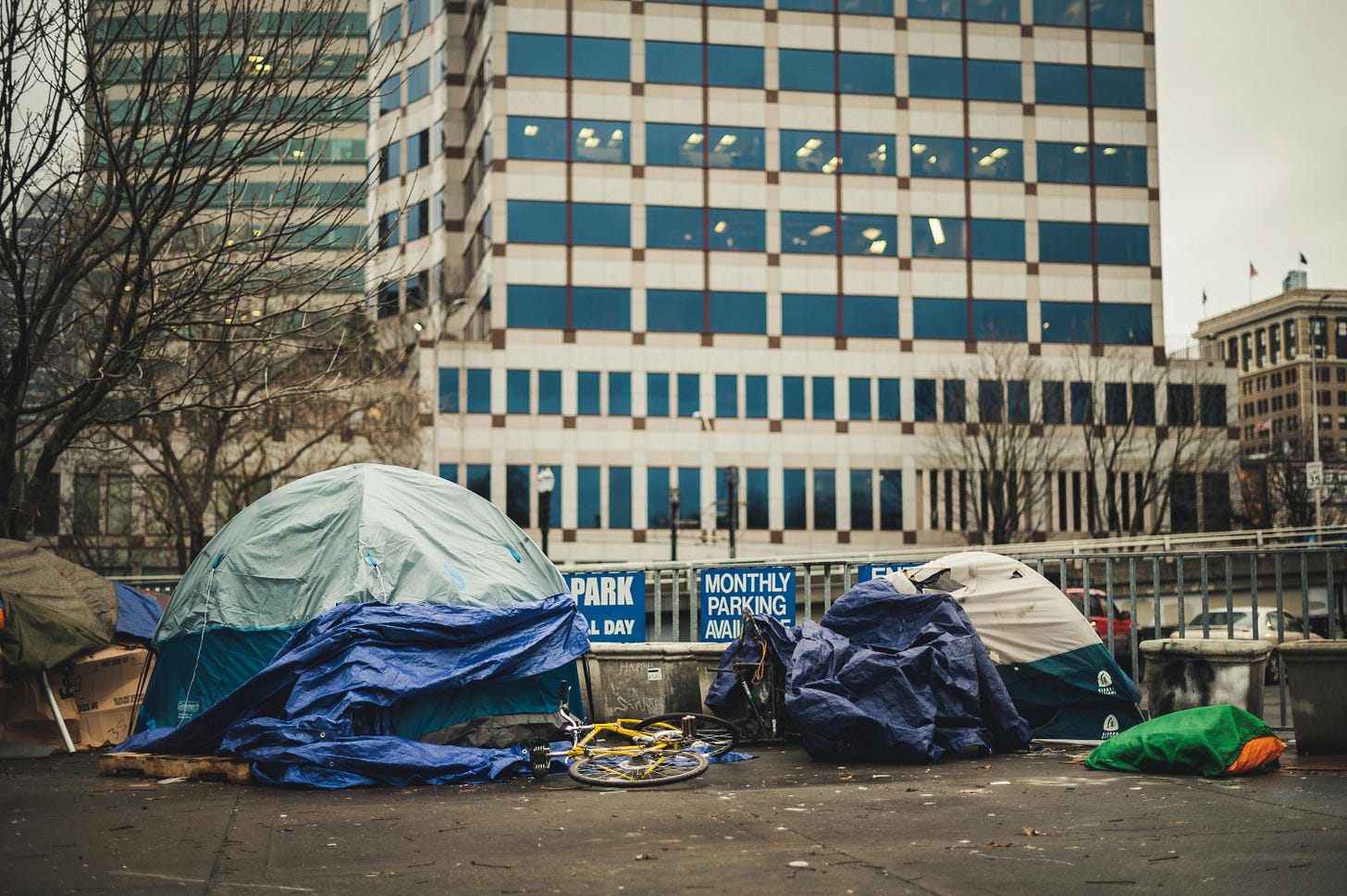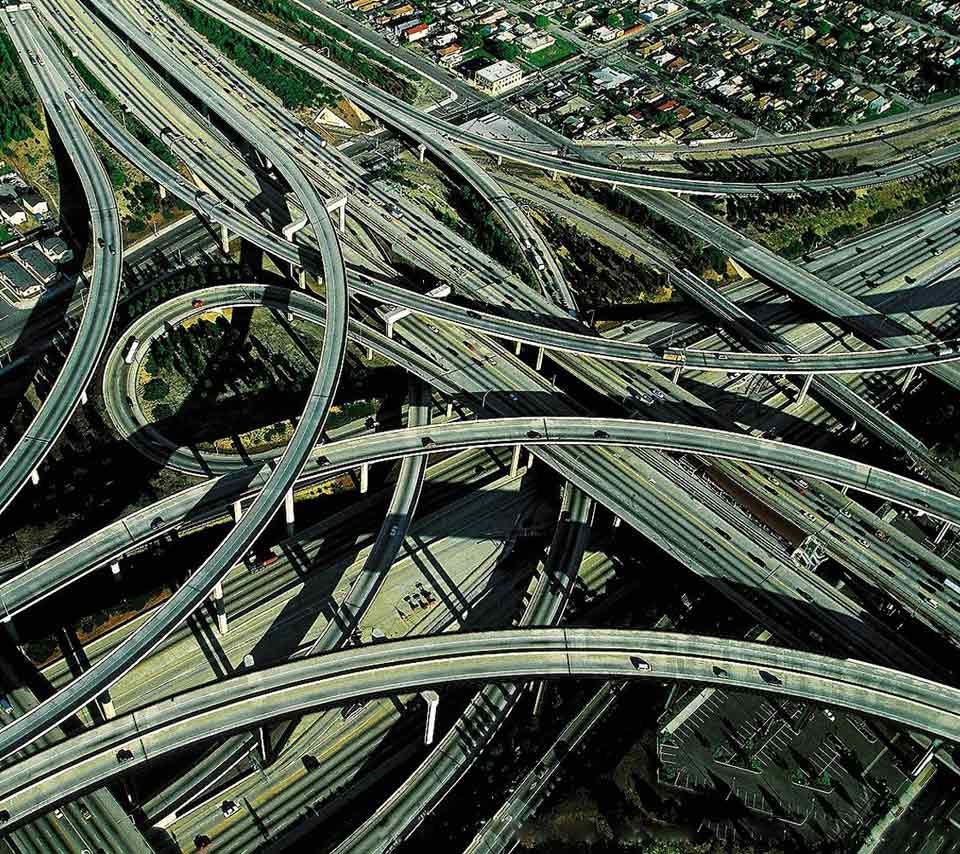This is part one of a three part series. Parts two and three will cover policing and energy systems.

Last Fall, I visited my grandparents’ apartment in Miami, Florida. My car’s aux was broken so I listened to NPR on the drive over, which was running a story about the housing crisis in U.S. cities. The “expert guest” listed explanations for why housing was in short supply, including high cost of labor, zoning laws, resource shortages and complex financial instruments. He painted an intricate picture, casting the 800,000 unhoused people in America as unfortunate, lost pieces in an otherwise complete puzzle.
I arrived at the apartment building, entered the elevator, and pressed the floor 12 button, noticing that floors two through seven were missing from the elevator panel. I later asked my grandmother about this, and she told me that those six levels are used for a parking garage. This was perhaps an obvious answer, but in the moment, after I had just listened to the housing shortage story, it struck me as bizarre. How could there be so much space and resources dedicated to sheltering cars, but not enough for sheltering people?
Structural problems with our society are often presented as inevitable byproducts of otherwise effective systems. We are made to believe that it is perfectly normal to secure housing for cars before guaranteeing housing for every human; that homelessness is a “natural” price that some must pay so that others can live prosperous, secure lives. Because capitalist housing/food/healthcare systems are supposedly righteous, individuals who lack basic human needs (shelter, food, healthcare) have failed in some fundamental way. Maybe they are lazy or made bad choices.
Any person with an observant eye and keen sense of curiosity can recognize countless ways in which our world is built on nonsensical, inhumane principles. This is more apparent now than ever, as a fascist regime of incompetent egomaniacs strip away any semblance of a functioning government. However, as we go about our usual lives, the inadequacies of the current world can feel “natural,” because this world is the only one that we have ever known.
The way things are is not natural. The failure of our housing system to provide houses is just one example. It is unnatural to value two-ton hunks of polluting, deadly metal more than our neighbors; for our cities to treat unhoused people like rodents. I refuse to believe that there is some legitimate moral or logistical reason for this. Which leads me to a familiar question: Why?
Why are cars housed before people? Why are 800,000 people unhoused in “the richest country in the world?”

The straightforward answer to “why homelessness exists in the United States” is neoliberalism, the privatization of industries that provide basic needs like housing. A neoliberal housing system views houses as a vessel for corporations and landlords to extract profit, rather than a means to shelter humans. The economic justification for homelessness is simple: constricting the supply of available housing allows landlords to charge higher rents and extract more profit. Fewer houses = higher rents = increased profits.
Of course, the other side of the coin is: Fewer houses = higher rents = more people unhoused. As rents rise exponentially faster than wages, many people can no longer afford their rent and they are eventually evicted, left without a home.
But sheltering people is not the goal of our housing system. Private developers and landlords are incentivized to maintain a constant supply shortage, creating an adversarial relationship between those who profit from housing and those who simply need a home to live. More people unhoused is directly correlated with increased profits.
Two deliberate and predatory results of neoliberal housing policy are:1
Tenants paying a higher % of their income on rent, requiring multiple jobs, causing food insecurity, and less time/energy/money to fight back, to relax, to travel, to live.
Homelessness for nearly 800,000 people who are denied the right to housing.
The relationship between privatized housing and homelessness is not a well-kept secret. Former Los Angeles Mayor Eric Garcetti once stated: “In a good economy, homelessness goes up.” Government-backed ‘housing solutions’ reflect this assertion. Instead of supporting rent control, eviction bans and public housing–all real housing solutions–many housing policies revolve around subsidizing private developers.
Two private equity firms, Blackstone Group and Starwood Capital are among the largest owners of government-subsidized housing, owning nearly 150,000 units. The idea behind public-private partnerships is that public subsidies for private developers theoretically allows corporate landlords to charge lower rents. Except the largest real estate developers have a track record of doing the opposite, including pursuing evictions after the Covid eviction ban was enacted and lobbying against rent-control legislation. Both real estate companies and the government view housing as a means of profit, rather than a means of living. There is nothing natural about this.
Nor is there anything natural about prioritizing parking garage infrastructure over housing. The city of Minneapolis owns 14 parking garages, totalling around 1.3 million sq. ft of space.2 On average, a 2.5 bedroom housing unit is 1,000 sq. feet, meaning that the space currently dedicated to city-owned car homes could provide 3,286 person homes. This calculation does not factor in the surface lots owned by the city, dozens of private parking garages, and 320 abandoned buildings in the city which could be revitalized.
To be clear, I don’t think that abolishing parking garages is a good housing policy. Most cities have car-dependent infrastructure and people do rely on parking to go about their lives. But the ability to support car infrastructure does point to the fact that when something is a priority, cities are capable of making it happen. If we can construct dozens of car garages, not to mention labyrinthian highway systems, there is no reason why we can’t build homes.
I mean seriously, look at this image and tell me this is feasible for the government but expanding public housing isn’t.
Then there’s the rhetorical angles crafted to justify inhumane housing policy. When I was in highschool in Miami, an Instagram graphic spread about ‘homeless people hiding HIV-infected needles under gas pump handles.’ This rumor, which turned out to be entirely false, started on Facebook and made the rounds on reactionary local news channels. Being a dumbass 16-year old, I believed it and was legitimately terrified to fill up my gas for weeks. This ridiculous story of unhoused people ‘spreading HIV via gas-pumps’ is just one example of dehumanizing anti-homeless rhetoric.
Basic logic points to the fact that the priority of unhoused people is securing food, water, shelter, and clothes–not attacking you and I. But a housing policy that denies people of their human rights needs to justify itself somehow. Stories of the unhoused being ‘dangerous vagrants out to get us hard-working folk’ are constantly running on national media outlets and local news channels. This is not to say that unhoused people never steal things or harm others–people facing extreme poverty have limited survival options.
However, these instances are often blown out of proportion or fabricated, which serves a clear purpose for the political and corporate elite, whose housing policy relies on a steady increase of homelessness. Constructing an image of unhoused people as rodents to be exterminated, rather than humans to be housed, is an attempt to justify nonsensical policy.
If you believe that housing is a human right, then there is no justification for hundreds of thousands of people living on the streets. It really is that simple. The existence of homelessness is an indictment of our entire housing system, just as food insecurity is on food systems, police executions on police systems, climate catastrophe on energy systems. None of these things are natural; they are made by humans (the most powerful ones) and can be undone by humans (us).
Change is not constrained by possibilities; it is constrained by power.
Organizers around the country are building grassroots power in a variety of ways. In the book “Abolish Rent,” Tracy Rosenthal and Leonardo Vilchis share stories of the LA Tenants Union, the largest tenants union in the country. Their 15 local chapters and 3,000 members deploy a variety of tactics to challenge rising rents and the threat of eviction, all centered around fighting for housing as a human right. Some of their victories include organizing the largest rent strike in LA history, winning $15 million in city rent assistance and mobilizing to defend the Echo Park encampment from eviction. People in South Minneapolis recently started organizing a local tenants union too, sharing information on tenants rights and hosting monthly community meetings. Tenants unions are one strategy to defend people’s homes against the grip of real estate corporations and landlords.
For people completely abandoned by the housing system, left without a roof over their heads, encampments are a vital source of community and resources. In 2023, Nenookaasi Healing Camp formed as a single encampment to support over 100 mostly Indigenous people in the Phillips neighborhood of South Minneapolis. The camp established mutual-aid networks, connecting people with long-term housing, sharing meals and warm clothing, even reversing overdoses. But during the first two months of 2024, police-enforced evictions forced the encampment to relocate three times, before they eventually decentralized among several locations. Camp Nenookaasi and encampments across Minneapolis are under constant threat of eviction from police.3 Criminalizing homelessness, bulldozing encampments and dumping concrete rubble on abandoned lots are the best solutions our current housing system has to offer.

We are capable of treating each other with mutual respect and developing governance structures to reflect this value. So what could a just housing system look like?
One national group, the Alliance for Housing Justice, developed the concept of Social Housing as an alternative to our privatized housing system. It’s a simple model, guided by eight principles:
Social Ownership: housing wholly owned by residents, community land trusts, or a public entity.
Permanent Affordability: rent and utilities cost can never exceed 30% of tenant income.
Decommodification: Housing is no longer a means of profit, a necessary prerequisite for making housing affordable and available.
Community Control: people have a democratic voice in planning, developing and constructing housing in their communities.
Anti-discrimination & Equity: Undoing the racist histories of gentrification and disinvestment from Black, Brown and poor communities by ensuring access to social housing.
Sustainability: Housing that is energy efficient and disaster resilient.
Tenant Protections: Tenants have the rent control, the right to organize, and the right to legal council.
Accessibility: Housing built to accommodate disability needs.
It is tempting to dismiss broad ideas of change as impractical or unrealistic. I understand this impulse; I am prone to it too. But it can be eye-opening to take a step back from the cynicism of the status-quo and realize just how out of whack the current world order is.
Do not let anybody tell you that it is unrealistic to dream of a world where every person has a roof over their head. This will not be accomplished through the reform policies of coercive, competitive markets, but through the organizing of everyday people. The work has already begun in the places we live. From tenants unions, to encampment solidarity networks, to community-land trusts and visionary housing justice organizations, there are ways to get plugged in.
Collectively, we are incredibly creative and resourceful people, capable of meeting each other’s needs while building something better.
You can subscribe for free to be notified when I share new writing.
If you’re able to financially support my work, paid subscriptions allow me to spend more hours writing! Free subscriptions and sharing with friends is also helpful and I am appreciative of each and every one of you
There is a long, devastating history of how this (un)housing policy came into existence, which I’ll spare you of for now, but if you are interested, I recommend reading “Abolish Rent” by Tracy Rosenthal and Leonardo Vilchis.
Source: https://www.minneapolismn.gov/getting-around/parking-driving/parking-ramps-lots/
More on this next week.





